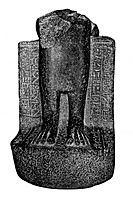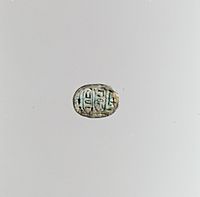Kashta facts for kids
Quick facts for kids Kashta |
|||||||||||
|---|---|---|---|---|---|---|---|---|---|---|---|
| Kushite King of Napata | |||||||||||

Bronze situla with the names of Kashta and Amenirdis I. Walters Art Museum.
|
|||||||||||
| Predecessor | Alara | ||||||||||
| Successor | Piye | ||||||||||
| Burial | el-Kurru | ||||||||||
| Spouse | Pebatjma | ||||||||||
| Issue | Piye, Shabaka (sons); Khensa, Peksater, Amenirdis I, Neferukakashta (daughters) | ||||||||||
| prenomen |
M3ˁ-Rˁ - Maa-Ra - Ra is just |
||||||||||
| nomen |
k3š-t3 - Kashta |
||||||||||
Kashta was a powerful king from the 8th century BC. He ruled the Kushite Dynasty in ancient Nubia. His name, Kashta, means "The Kushite."
Kashta was an important ruler because he began to expand the influence of his kingdom into ancient Egypt. His son, Piye, later became famous for conquering all of Egypt and starting the Twenty-Fifth Dynasty.
Contents
Kashta's Family and Royal Connections
Kashta's only known wife was Pebatjma. Together, they had several children who played important roles in the Kushite kingdom.
Kashta's Children
- King Piye: He was a son of Kashta and likely Pebatjma. Piye later became a great king who conquered Egypt.
- King Shabaka: He was another son of Kashta and Pebatjma. He also became a king after Piye.
- Queen Khensa: She was a daughter of Kashta and possibly Pebatjma. Khensa married her brother, King Piye.
- Queen Peksater: Also known as Pekareslo, she was married to King Piye. She was buried in Abydos, an ancient city in Egypt.
- God's Wife of Amun Amenirdis I: She was a very important daughter of Kashta and Pebatjma. Her role helped the Kushites gain power in Egypt.
- Neferukakashta: She is thought to be another daughter of Kashta and possibly Pebatjma.
Kushite Influence in Upper Egypt
Kashta ruled Nubia from his capital city, Napata. This city was located about 400 kilometers north of modern-day Khartoum, the capital of Sudan.
During his reign, Kashta greatly increased Kushite power in Upper Egypt. He did this by arranging for his daughter, Amenirdis I, to become the "God's Wife of Amun" in Thebes.
The Role of God's Wife of Amun
The "God's Wife of Amun" was a very powerful religious and political position in ancient Egypt. By placing his daughter in this role, Kashta officially gained control over the Thebes region. This was a key step in the Kushite expansion into Egyptian lands.
Historians believe that Kashta likely had Kushite soldiers stationed in Thebes. These soldiers helped protect his authority and prevent any attacks from Lower Egypt.
Evidence of Kashta's Rule
A special stone tablet, called a stela, was found in Elephantine (modern-day Aswan). This stela has Kashta's royal name on it, showing that he controlled this area.
Some experts believe that Kashta was the first Kushite king to truly expand his kingdom's influence into Upper Egypt. Because of this, some consider him the founder of the 25th dynasty. During Kashta's time, the people of Kush quickly adopted many Egyptian traditions, including their religion and culture.
Kashta's Burial Place
Kashta was buried in a special cemetery called el-Kurru. This site contains the tombs of Kashta and several kings who came after him.
His tomb is a pyramid, and his wife Pebatjma is also believed to be buried nearby. Other important kings, like Piye and Shabaka, were also buried in pyramids at el-Kurru.
Images for kids
See also
 In Spanish: Kashta para niños
In Spanish: Kashta para niños




